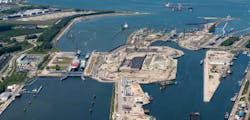LNG-fueled Container Ships will be powered by Wärtsilä dual-fuel engines
By Rod Walton, EnergyTech Senior Editor
Finland’s Wärtsilä will supply engines, control systems and other digital technology for liquefied natural gas (LNG)-fueled container ships belonging to a French-based shipping company.
CMA CGM selected Wärtsilä for equipping 12 container vessels to be built in China. All of the ships can run on LNG, which is natural gas chilled to a point making it liquid and easier to store.
The dual-fuel gas engines on the vessels are already compatible with renewable energies such as biomethane, synthetic methane and e-methane. Wärtsilä’s equipment is scheduled for delivery to the Chinese assembly yards later this year, and the first of the ordered ships are expected to be operational in 2023.
The equipment includes five Wärtsilä 34DF dual-fuel auxiliary engines—60 engines in total. The rest of the order includes Wärtsilä’s Nacos Platinum integrated control system, propulsion control systems, sewage treatment plants and fuel gas supply systems fitted with the operations and monitoring system.
"At CMA CGM we are committed to promoting sustainability in all our operations,” said Xavier Leclercq, vice president of CMA ships, in a statement. “We are happy to work with Wärtsilä as they have a similar decarbonization target and a very broad scope of solutions to offer. The choice of dual fuel gas vessels powered by LNG for our new ships is part of our commitment to build a zero-carbon future.”
Related story
Echandia to supply Fuel Cell-powered Ferry in Stockholm
Subscribe to EnergyTech's free, tri-weekly newsletters for more stories like this
Six 13,000 TEU container vessels are being built at the Hudong-Zhonghua Shipbuilding (Group) CO. Ltd, with the other six 15,000 TEU container vessels under construction at the Jiangnan Shipyard (Group) Co., Ltd.
LNG was chosen as the key fuel source because it emits less greenhouse gas than diesel. CMA CGM has announced commitments to decarbonize martime operations, eliminating nearly all sulfur oxide and nitrogen oxide emissions.





